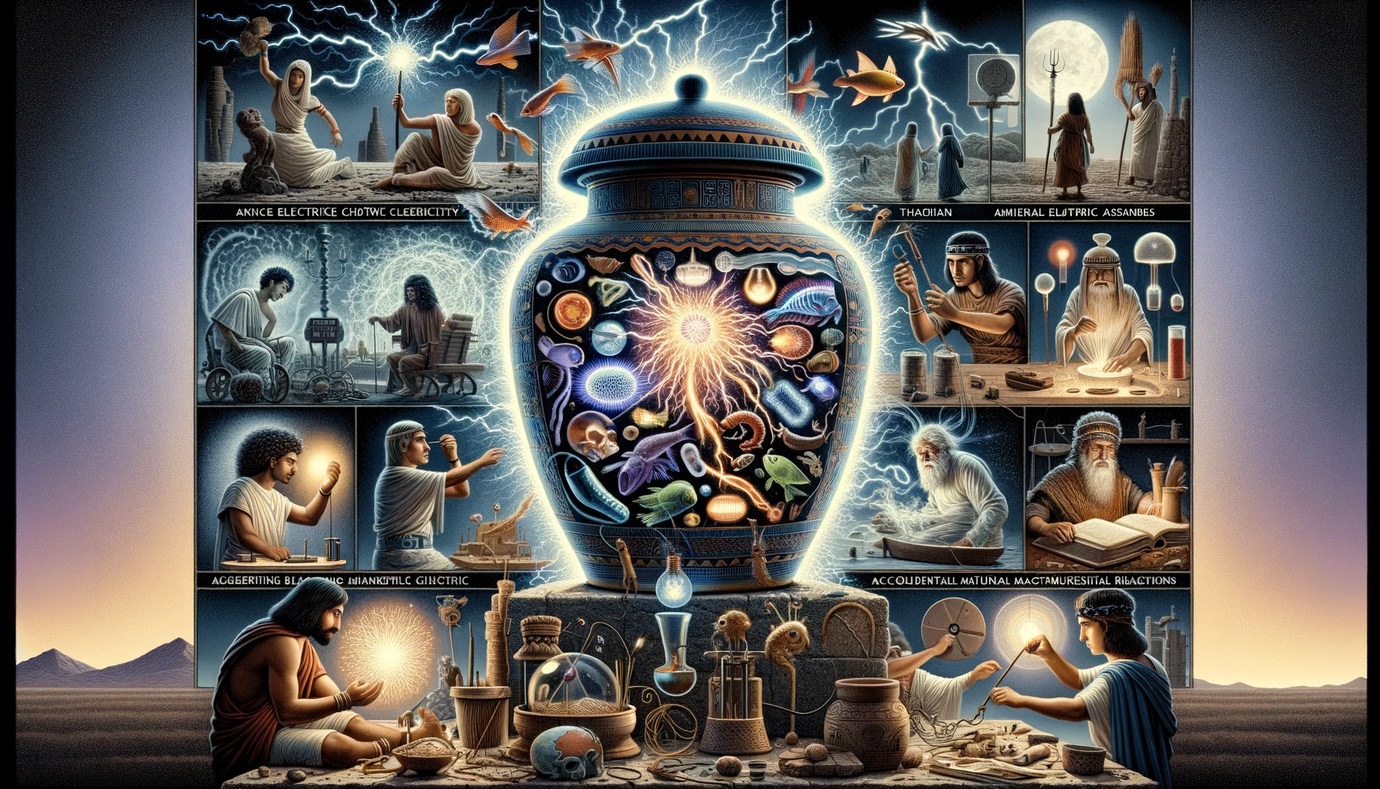The Mysterious Pull: Ancient Greeks and the Discovery of Magnetism
Introduction: The Force That Fascinates
Imagine a force unseen that can pull objects towards itself without anything touching them. This isn't a modern-day superhero story; it's about a discovery made over two thousand years ago. The ancient Greeks stumbled upon a rock that attracted iron, and this would lead them on a path to discovering magnetism. Magnetism was a term and a concept not yet formed, but the experience of seeing iron move as if by an invisible hand must have been startling. The Greeks, with their insatiable curiosity and inclination towards philosophy and the natural sciences, were poised to delve into this mystery, to explore and ponder its implications. Their observations and theories laid the groundwork for our understanding of the magnetic forces that invisibly govern the movement of certain metals.
The Lore of Magnesia's Stones
In a land known as Magnesia, which today is part of modern Greece, there were rocks that had a peculiar property. These weren't ordinary rocks; they could attract iron! The people of Magnesia were the first to note this strange phenomenon, and the stone was named 'lodestone', which we now know as magnetite. This remarkable material not only fascinated those who encountered it but also became shrouded in myths and legends as its properties seemed almost magical. Magnesia's lodestones became the subject of intense study and the stuff of stories among the Greeks, who began to document their properties, wondering about the nature of this unseen force and pondering its potential uses.
The Allure of Lodestone: Magnetism's Natural Wonder
Unearthing the Power of Attraction
Lodestone was the ancient world’s introduction to magnets. This dark mineral didn't need spells or magic to move things—it had a natural power that drew iron objects toward it. The ancient Greeks, in their pursuit of understanding, must have conducted countless experiments with this stone, watching in wonder as pieces of iron leaped across spaces to cling to it. Their world, filled with gods and myths, was no stranger to the idea of unseen forces, but here was a tangible piece of nature that clearly exhibited a powerful and consistent effect without any divine intervention.
Magnetism: The Invisible Force
Magnetism, the force behind this attraction, was a mystery to the ancient Greeks. It's an invisible energy that lodestone produces, which pulls on iron and some other metals, causing them to move without being touched. Today, we understand magnetism through the lens of physics as a fundamental force, but for the ancient Greeks, it was a phenomenon that blended the boundaries between the known and the unknown, between science and the supernatural. They observed how the stones not only attracted iron but could also stick to each other, and they began to theorize about the nature of these attractions.
Thales of Miletus: The Philosophical Pioneer
The Intellectual Inquiry Begins
One of the earliest thinkers to wonder about this was Thales of Miletus. He's known as one of the first scientists in history and was fascinated by the lodestone’s ability to attract iron. Thales was a polymath, someone who studied many subjects, and he approached the phenomenon of magnetism with a combination of curiosity and philosophical thinking. He proposed that the lodestone had a soul—a way to explain its movement and effects on other objects. This idea might seem strange to us now, but for Thales, it was an attempt to explain the unexplainable, to give life to the innate properties of natural objects that seemed animated by unseen forces.
Natural Philosophy and Magnetism
Back then, science was called 'natural philosophy.' It was all about observing nature and trying to understand how things worked. Thales and others like him observed and thought deeply about the powers of lodestone. They discussed and documented their properties, leading to a body of knowledge that, while not scientific in the modern sense, was rich in observation and theory. These early philosophical explorations were a crucial step toward a more empirical approach to understanding the world, setting the stage for later scientific methodologies.
The Ancient Greek Explanation of Magnetism
Theories Without Tools
The ancient Greeks didn't have the tools we have today to study magnetism, like microscopes or electricity. They had to rely on what they could see and think up theories to explain it. They believed that the lodestone had a soul, which was what gave it its power. This 'animistic' view was not just about giving life to inanimate objects; it was an earnest attempt to make sense of the world using the concepts and language they had. The idea of a 'soul' provided an explanatory framework for the observable effects of magnetism, attributing a form of essence or spirit to the stones that seemed to act of their own accord.
The Legacy of Greek Observations
Even though they didn't get everything right, the ancient Greeks set the stage for future discoveries. They were some of the first to write down their observations and theories, and that was a big deal for science! These documents provided a record of their thinking, offering a basis for future generations to build upon. Their approach to inquiry and learning, their dedication to observing the natural world, and their willingness to propose and debate theories set a precedent that would eventually lead to the development of modern science.
Greek Thinkers and Their Global Classroom
While the Greeks made many original contributions to science and philosophy, they didn't work in isolation. Many of the great thinkers of the era, including those who pondered the mysteries of magnetism, were part of a global classroom. They traveled to places like Kemet, known today as Egypt, which was a hub of learning and knowledge for centuries.
The schools in Kemet were famous for their depth of knowledge in various fields, including mathematics, astronomy, and medicine. It's believed that Greek philosophers, who are often credited with the birth of Western science, were heavily influenced by the teachings they received in Kemet and other centers of learning across the Mediterranean and Near East.
By acknowledging this exchange of knowledge, we can appreciate the magnetism discovery within a broader tapestry of cross-cultural learning and wisdom-sharing that was typical of the ancient world.
From Myth to Science: The Journey of Understanding
Magnetism's Path Through History
The understanding of magnetism has come a long way since the Greeks. In the Middle Ages and the Renaissance, scholars built on Greek ideas to learn more about this hidden force. The journey from myth to science wasn't straightforward or quick. It took centuries of experimentation, discussion, and refinement of ideas. From the Greeks to the scholars of the Islamic Golden Age, to the scientists of the Renaissance, each culture and era contributed to our understanding of magnetism, turning it from a mystical phenomenon into a well-studied scientific field.
The Building Blocks of Modern Science
All the thinking and writing the ancient Greeks did about magnetism was important. They were like detectives trying to solve a mystery without all the clues. Their work helped to develop the scientific method, a way to learn about the world that we still use today. The ideas they put forth about natural phenomena, the rigorous discussions they engaged in, and their commitment to understanding through observation were the building blocks upon which modern science was built.
Conclusion: The Timeless Attraction of Magnetism
The Enduring Mystery
The story of magnetism is one of curiosity and the drive to understand the world around us. It's a force that was mysterious to the ancient Greeks and still holds secrets for us to discover today. The allure of magnetism remains strong, as scientists continue to delve into its quantum mechanical roots and practical applications, from magnetic resonance imaging (MRI) in medicine to the vast fields of electromagnetism in physics.
Inspiring Future Discoveries
Just like the Greeks, we keep looking, wondering, and experimenting. Their early steps into the study of magnetism show us that asking questions and testing our ideas is how we make new discoveries. Who knows what mysteries we'll solve next? Our journey of discovery is unending, and every new piece of knowledge serves as a stepping stone to further understanding. The ancient Greeks taught us that it's not just the answers we find, but the questions we ask that push the boundaries of our knowledge and capabilities.










